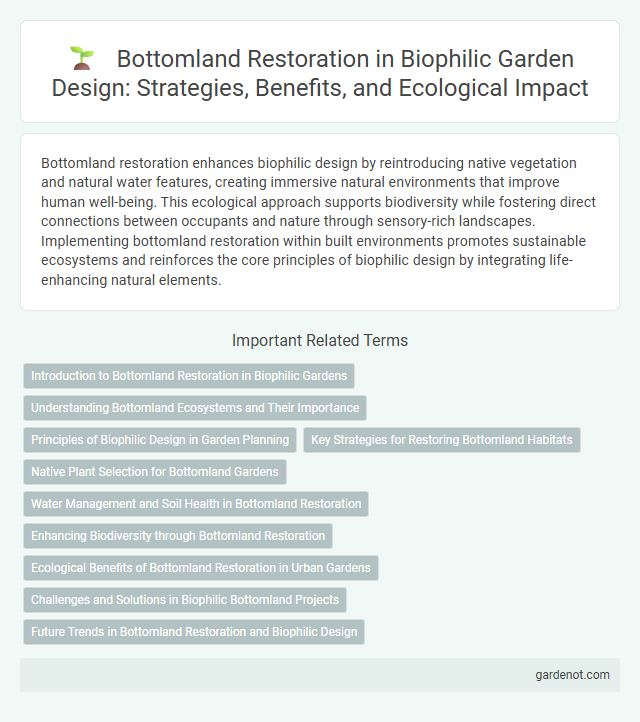Bottomland restoration enhances biophilic design by reintroducing native vegetation and natural water features, creating immersive natural environments that improve human well-being. This ecological approach supports biodiversity while fostering direct connections between occupants and nature through sensory-rich landscapes. Implementing bottomland restoration within built environments promotes sustainable ecosystems and reinforces the core principles of biophilic design by integrating life-enhancing natural elements.
Introduction to Bottomland Restoration in Biophilic Gardens
Bottomland restoration in biophilic gardens revitalizes floodplain ecosystems by reestablishing native plant species and natural water flow patterns. This ecological approach enhances biodiversity, supports wildlife habitats, and improves soil and water quality within urban environments. Integrating bottomland restoration into garden design promotes environmental resilience and fosters a deep human-nature connection through immersive, living landscapes.
Understanding Bottomland Ecosystems and Their Importance
Bottomland ecosystems are low-lying areas adjacent to rivers and wetlands characterized by diverse plant and animal species that thrive in periodically flooded conditions. Restoring bottomlands enhances biodiversity, improves water quality by filtering pollutants, and provides critical flood mitigation services. Understanding the hydrology and native vegetation of these ecosystems supports effective biophilic design strategies that integrate natural elements into built environments.
Principles of Biophilic Design in Garden Planning
Bottomland restoration integrates biophilic design principles by emphasizing natural water management and native vegetation to create a resilient, ecologically rich garden environment. Incorporating elements such as diverse native plant species, natural water features, and wildlife habitats fosters a deep human connection to nature while enhancing biodiversity. This approach promotes sustainability, supports local ecosystems, and improves mental well-being through immersive natural experiences.
Key Strategies for Restoring Bottomland Habitats
Key strategies for restoring bottomland habitats involve reestablishing native vegetation, controlling invasive species, and enhancing hydrological connectivity to support natural flood regimes. Implementing sediment management and restoring natural water flow patterns are critical for maintaining soil fertility and aquatic biodiversity. Monitoring ecological indicators ensures adaptive management practices sustain habitat resilience and promote the return of native wildlife populations.
Native Plant Selection for Bottomland Gardens
Selecting native plants for bottomland gardens enhances ecosystem resilience by supporting local wildlife and improving soil health. Species like swamp milkweed, buttonbush, and bald cypress thrive in wet conditions and contribute to natural water filtration and flood mitigation. Incorporating these native plants creates a sustainable, biophilic landscape that restores bottomland habitats and promotes biodiversity.
Water Management and Soil Health in Bottomland Restoration
Bottomland restoration enhances water management by improving natural flood control and groundwater recharge, reducing runoff and sedimentation. Healthy soil in bottomland areas boosts nutrient cycling and organic matter retention, supporting diverse plant and microbial communities. This synergy between water and soil health is essential for resilient ecosystems and improved habitat quality.
Enhancing Biodiversity through Bottomland Restoration
Bottomland restoration revitalizes floodplain ecosystems by reestablishing native vegetation and hydrological functions, which creates critical habitats for diverse wildlife species. Enhancing biodiversity through this practice supports populations of amphibians, birds, and aquatic organisms, promoting ecological resilience and connectivity. Restoration projects improve water quality and soil fertility, fostering complex food webs and enriching overall ecosystem productivity.
Ecological Benefits of Bottomland Restoration in Urban Gardens
Bottomland restoration in urban gardens enhances biodiversity by creating native wetland habitats that support diverse plant and animal species. These restored wetlands improve water quality through natural filtration, reducing urban runoff and mitigating flood risks. Integrating bottomland ecosystems in cities promotes ecological resilience and helps regulate microclimates, contributing to sustainable urban environments.
Challenges and Solutions in Biophilic Bottomland Projects
Bottomland restoration in biophilic design faces challenges such as soil erosion, invasive species control, and water management to reestablish native biodiversity and natural hydrology. Effective solutions include implementing erosion control measures like native plant buffers, applying adaptive invasive species management, and designing hydrological features that mimic natural flood regimes. Employing these strategies enhances habitat resilience and promotes ecological balance in urban and suburban bottomland environments.
Future Trends in Bottomland Restoration and Biophilic Design
Future trends in bottomland restoration emphasize integrating biophilic design principles to enhance ecosystem services and human well-being simultaneously. Innovative approaches focus on restoring native wetland vegetation, improving water quality, and creating habitat connectivity while promoting community engagement through natural spaces. Advanced modeling and remote sensing technologies facilitate precise monitoring of restoration success and adaptive management in bottomland ecosystems.
Bottomland restoration Infographic

 gardenot.com
gardenot.com